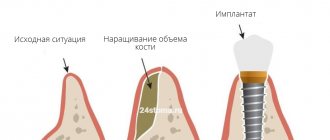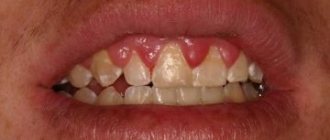There is a disease that combines inflammation, infectious infection, tissue necrosis, and occurs in the jaw bone, close to the facial muscles, mucous membrane, facial skin, main arteries, respiratory tract, and a huge number of lymph nodes. This disease is called osteomyelitis of the jaw. What kind of disease is this and why is it so dangerous?
Due to the symptoms adjacent to other diseases, the disease is difficult to diagnose. It can lead to serious diseases of internal organs, deformation and fracture of the jaw, blood poisoning and even death.
Osteomyelitis is a process that occurs in the bone, bone marrow, and soft tissue surrounding the inflammation. The word “osteomyelitis” is Greek, formed from three different words - “bone”, “brain” and “inflammation”, which accurately conveys the essence of the disease.
Osteomyelitis is caused by pus-producing bacteria and mycobacteria. The disease is dangerous because the infectious process can invade the entire bone, bone marrow, lead to necrosis, deformation, entail many unpleasant consequences and concomitant diseases, and become chronic.
What is osteomyelitis of the jaw?
Osteomyelitis of the jaw is also called necrosis of the jaw. This is an extremely dangerous disease. The fact is that, unlike osteomyelitis of other bones, which is caused by just one type of bacteria introduced into the blood only through the blood (most often streptococci and staphylococci), osteomyelitis of the jaw is distinguished by a huge number of infection options and a variety of pathogens. These can be staphylococci (golden and white), pneumococci, streptococci, E. coli or typhoid.
The disease affects not only the jaw, but also the entire skeletal system. Leukocytes immediately begin to “treat” the infection in the bone, and the products of their treatment begin to decompose the bone. Purulent cavities form in the bone, necrosis begins, the jawbone becomes fragile, deformed and can break.
In addition to the bone, the soft tissue surrounding it can become inflamed - gums, nearby muscles, salivary glands, facial skin. In the absence of timely treatment, the infection spreads throughout the body. With osteomyelitis of the upper jaw, inflammation can quickly spread to the orbits, and swelling begins. Lymph nodes quickly respond to inflammation in the body. In severe cases, ulcers develop in the soft tissues of the face.
There are many ways in which osteomyelitis can occur. These can be protracted or chronic infectious and viral diseases that are not completely cured or occur with complications, dental diseases, infections with inflammation, tooth extraction, blood transfusions, severe injuries - wounds and fractures. The resulting injuries can be not only in the jaw itself; with certain types of infection, the infection can penetrate into the jaw later.
Most often, men suffer from osteomyelitis of the jaw, but it is most dangerous for young children, in whom the disease develops rapidly and its diagnosis is difficult. How to diagnose osteomyelitis and begin proper treatment? What types of osteomyelitis of the jaw occur?
Causes
The main reason for the development of osteomyelitis of the jaw is the penetration of highly pathogenic microorganisms into the bone tissue. Infection can occur in several ways:
- Odontogenic way, when the source of the infectious agent is a tooth affected by caries. In this case, microorganisms first enter the pulp tissue, after which they spread through small lymphatic vessels or dental tubules to the bone tissue.
- Hematogenously, when pathogenic microorganisms spread to the maxillofacial area through blood vessels from the primary source of infection. This role can be played by any infectious focus present in the body: acute or chronic tonsillitis, erysipelas or furunculosis. In addition, some specific infections can provoke osteomyelitis: typhus, scarlet fever or even the common flu.
- Traumatically, when osteomyelitis occurs against the background of infection after a fracture or surgery on the jaw. It is most rarely seen in dentistry.
With the odontogenic route, the lower jaw is most often affected, and with the hematogenous route, the upper jaw is most often affected. If the infection occurs hematogenously, then the localization of the purulent focus will be deep in the bone tissue, and the phenomenon of periostitis will be minimal.
Types of osteomyelitis of the jaw
There are many types of osteomyelitis of the jaw; they are determined depending on where, how, for what reason and with what consequences the infection occurred.
| By place of origin | By distribution | By method of infection | According to the nature of the flow |
|
|
|
|
First of all, localization. Osteomyelitis of the jaw can develop in both the upper and lower jaw. Because the mandible is mobile, it is more susceptible to infection, so osteomyelitis of the mandible is more common. Judging by the statistics, osteomyelitis of the upper jaw is more common in children and is more difficult to diagnose, but with proper treatment it goes away easier and faster.
Osteomyelitis of the jaw can be diffuse and limited. Limited - if the localization of infection is only on the bone and bone marrow. If the infection spreads to the surrounding soft tissues, into the blood, then this is a diffuse type of disease.
By method of infection
Infectious
Osteomyelitis is caused by an infection in the jaw bone. At this moment, cavities form in the bone, usually filled with pus, which deform and destroy the bone, transfer to soft tissue, and sometimes into the blood. Depending on the bacterium that caused the disease, infectious osteomyelitis is divided into specific and nonspecific. If the cause of osteomyelitis of the jaw is typical bacteria (streptococci and staphylococci), then such osteomyelitis is called nonspecific. Specific osteomyelitis is an infection with syphilitic, actinomycotic or tuberculosis bacteria.
Most often, infection occurs due to complications of stomatitis, alveolitis and other dental diseases. Through the affected tissue, the infection penetrates into the pulp and through the root of the tooth reaches the jaw. It can also occur if benign tumors are not treated.
Traumatic (non-infectious)
The cause of the disease is trauma - a fracture, wounds through which bacteria that cause infection penetrate into the wound. Most often this is a facial bone injury.
Traumatic osteomyelitis of the jaw is especially distinguished after tooth extraction, when the dental nerve is not completely removed and suppuration of the cavity begins. The tooth may not be completely removed according to the dentist’s indications.
This also includes the radiation type of osteomyelitis - when the jaw bone is damaged by a malignant tumor. May occur due to a course of radiation or chemotherapy. Sometimes it starts with incorrectly made prosthetics.
Osteomyelitis infection can be affected by iatrogenic causes - this is a deterioration in a person’s condition, unintentionally provoked by a physician. There are many medical operations that can cause infection in the jaw - both mandatory and cosmetic. Dental prosthetics, tooth extraction, filling, jaw fracture treatment, facial plastic surgery. There is always a risk of infection, but it is important to remember that osteomyelitis can only begin and spread in people with low levels of immunity. Therefore, it is extremely important to maintain immunity and take care of your body.
Hematogenous
It occurs when an infection spreads throughout the body through the blood, most often due to purulent diseases such as boils and sore throat. An infectious disease (scarlet fever, influenza, respiratory diseases and others) can also cause complications with subsequent infection. Most often develops in the chronic form of the disease.
Sometimes allergic osteomyelitis of the jaw is also isolated, when infection begins due to an allergy attack that triggers the process of inflammation and suppuration. But this type of osteomyelitis also directly depends on the immune system and begins only if the body is weakened.
According to the nature of the flow
Acute form
The acute form of the disease begins quickly and is characterized by an immediate rise in temperature to high levels of up to forty degrees, all signs of inflammation, and swelling of the face. The patient shakes with chills, his face turns red, the tissues swell, the headache radiates in different parts of the head, mainly in the temple, eye socket, and cheek. Acute osteomyelitis is the easiest to diagnose because its symptoms are the most obvious. A similar set of symptoms is characteristic of tumors - benign and malignant, various pains in the teeth, and inflammation of the gums.
Pre-acute
Preacute osteomyelitis is the next stage after acute, signs of inflammation begin to disappear, but the inflammatory process continues. At this point, it is necessary to continue treatment, otherwise there is a high risk that the disease will progress to the chronic stage, the most dangerous.
Chronic
Chronic osteomyelitis does not necessarily follow from acute osteomyelitis. If the disease has become chronic from untreated osteomyelitis or due to weak immunity, which does not allow one to immediately defeat the disease, this type is called secondary chronic, it is secondary after acute osteomyelitis. This chronicle shows mild symptoms and is characterized by outbreaks of exacerbations and periods of “calm.” Fistulas appear through which pus flows from the source of inflammation, but the source of inflammation itself begins to spread throughout the body, can spread to internal organs, blood, and destroy necrotic jaw bone.
Primary chronic osteomyelitis is difficult to diagnose, since the patient has not previously experienced attacks with exacerbation of the disease. This type of osteomyelitis most often occurs in children whose primary teeth are replaced by permanent teeth at the age of five.
There is a special type of osteomyelitis of the jaw, which is called desmorphine. It occurs only in drug addicts who receive the drug through injections. When the drug affects the blood supply, the jaw festers, collapses, the bone becomes brittle, easily breaks, becomes deformed, and the face becomes asymmetrical.
Rare forms of osteomyelitis of the jaw
Recurrent
Recurrent multifocal form, in which foci of inflammation appear in the bone, but with no suppuration or infection. The disease is difficult to define because it is characterized by periods of attenuation and progression.
Osteomyelitis Garre
Garre's osteomyelitis - osteosclerosis is visible on the x-ray, the tissue is not very compacted, inflammation and infection in the bone are mild. Difficult to diagnose.
Brody's Abscess
Brodie's abscess - there are practically no external symptoms of the disease, and this is why it is especially dangerous, because it is accompanied by the formation of purulent areas in the jaw bone. This disease is a type of bacterial osteomyelitis in a chronic form. In this case, X-rays will not give a clear picture of the disease, because inflammation cannot always be determined on an X-ray, and areas filled with pus cannot be accurately diagnosed. It can begin not only in the jaw bone, but in any bone in the body. There are also no characteristic features of the patient - the disease can begin at any age, but more often in males and in childhood.
Osteomyelitis Ollier
Osteomyelitis Ollier (Olle) is a disease caused by staphylococcus, a rather rare form of osteomyelitis, since the non-purulent areas formed with it are characterized by a high protein content.
The disease belongs to the chronic form of osteomyelitis. A very rare, almost unique disease, most often found in adolescents and children.
Most often it begins not in the jaw bone, but in the femur. Does not lead to suppuration and is characterized by a high protein content in the cavity. It is also difficult to diagnose.
The pain that appears slowly begins to grow and intensify if the body experiences stress. A swelling appears around the area with the protein-filled cavity, which increases in size and sometimes turns red.
Diagnostics
Based on the patient’s complaints and objective data from a general examination, the doctor may suspect osteomyelitis of the jaw bone. Confirmation of such a disease and a full formulation of the diagnosis are possible only after radiological diagnostics (x-ray diagnostics).
There are early and late radiological signs that indicate the presence of such severe pathology.
X-ray image: acute osteomyelitis of the jaw
Early X-ray signs include:
- the presence in the images of areas of rarefaction of bone tissue, which alternate with its compaction;
- blurriness and extreme indistinctness of the bone pattern in the jaw;
- a slight increase in the thickness of the periosteum as a consequence of periostitis.
Late signs of osteomyelitis on a radiograph are:
- the formation of foci of destruction with the formation of sequesters by 7-12 days from the onset of the disease;
- thickening and moderate compaction of bone tissue around the inflamed lesion.
In difficult cases, patients are advised to undergo MRI, which allows them to more clearly see the extent of bone tissue damage, as well as visualize small purulent foci.
In addition to the X-ray examination, general clinical tests are carried out, which reflect the activity of the inflammatory process:
- a general blood test, which can reveal an increase in the number of leukocytes, changes in the leukocyte formula of an inflammatory nature, a decrease in the number of red blood cells and hemoglobin;
- biochemical blood test to identify electrolyte disturbances and the appearance of inflammatory markers.
In order to determine the causative agent of osteomyelitis and identify its sensitivity to antibacterial drugs, a bacteriological study of the discharge of the fistula tracts is carried out with the inoculation of pus on special nutrient media, followed by microscopy of the obtained samples.
Symptoms of osteomyelitis
Symptoms of osteomyelitis are determined depending on its type. The acute form of the disease is characterized by the following symptoms:
- a sharp increase in temperature to 39-40 degrees;
- feeling of “coated” tongue;
- headache, weakness;
- sleep problems;
- loss of appetite;
- ulcers appearing on the face;
- change in color of the mucous membrane - it becomes paler;
- inability to close the jaw.
The pain can radiate to other parts of the head - the ear on the affected side, the eye socket, the temple. The face swells, becomes deformed, and the teeth on the sore jaw begin to “loose” in the gum when pressed. It is difficult to eat and speak, and moving the jaw causes pain.
In an extremely rare, toxic form of acute osteomyelitis, high fever causes confusion and loss of consciousness.
If acute osteomyelitis begins on the upper jaw, the inflammation often spreads to the cheek and orbit. Osteomyelitis of the upper jaw most often occurs in children when changing baby teeth, and suppuration in the orbit makes diagnosis difficult.
Symptoms of preacute osteomyelitis are less pronounced. Fistulas are formed through which pus comes out, the pain subsides, the teeth above the source of inflammation become more mobile. The sick person feels better and believes that the disease is going away, while the inflammation continues to intensify and spread throughout the body.
Chronic osteomyelitis, especially its primary form, is even more difficult to identify by symptoms. This should be done by a specialist using tests and x-rays.
Symptoms of osteomyelitis of the jaw in children
The symptoms of the disease are especially noticeable for children under five years of age. At this age, baby teeth are replaced by permanent ones, and children are just learning how to brush their teeth properly, so there is a high risk of a rapidly developing infection. If baby teeth become infected, the disease can spread and destroy the buds of permanent teeth. But when making a diagnosis, it is important that the doctor perform a biopsy and exclude the possibility of a malignant neoplasm.
As in adults, children's temperature rises sharply, the face swells, the skin becomes painful and turns pink. Lymph nodes enlarge, swelling spreads to the neck and can cause the airways to close, making it difficult for a person to breathe. When the body becomes infected, the load shifts to the blood and internal organs, the liver and spleen suffer, and kidney problems begin. The disease can lead to complications and even death.
Differential diagnosis
Differential diagnosis of osteomyelitis with other diseases that have similar symptoms is important, since an incorrect diagnosis can lead to an incorrect choice of treatment tactics and ineffective therapy. All this increases the risk of an unfavorable outcome of the disease and a poor prognosis for future health.
The differential diagnosis of osteomyelitis should include such diseases as:
- acute form of periodontitis,
- acute pulpitis,
- periostitis,
- suppuration of a tooth cyst,
- acute sinusitis of odontogenic origin,
- abscess of soft tissues in the maxillofacial area (MFA).
Treatment
First of all, after establishing the correct diagnosis, it is necessary to hospitalize the patient. It is best to choose large clinics where the diagnosis will be more accurate.
Treatment of osteomyelitis due to injury or a broken tooth should begin with surgical intervention - eliminating the consequences of the injury, removing tooth fragments. Only after this the patient is transferred to traditional antibiotic treatment.
The patient is prescribed antibacterial therapy, antibiotics, intoxication, vitamins and immunostimulants, transfusions of plasma and other blood substitutes. Often osteomyelitis appears together with concomitant diseases or complications, and in this case they must be treated in a mandatory complex. If the cause of the disease is injury, the consequences of the injury are first eliminated and only then treatment begins. The condition of internal organs to which inflammation may spread, as well as the condition of the blood, should be monitored to prevent the possibility of sepsis.
First of all, suppuration is removed and the spread of tissue necrosis is stopped. Inflamed bones become fragile and can break with little effort, which deforms and disfigures the face, so treatment begins as early as possible.
To combat suppuration, hemosorption and hyperbaric oxygenation are sometimes used.
During hemosorption, the blood is purified from poisons and harmful substances by passing it through sorbents that absorb poison and harmful substances from the blood. Hyperbaric oxygen therapy is a pressure chamber treatment that increases the amount of oxygen in the blood. The treatment method helps to saturate soft tissues susceptible to necrosis with oxygen, and to conduct oxygen in the blood in case of onset of blood sepsis and septic shock.
Antibiotics are immediately prescribed - the sooner the fight against inflammation begins, the more effective it will be.
In the future, physiotherapy is prescribed and courses of antibiotics are continued. If the symptoms disappear, you cannot stop the course of treatment: the disease can go into a latent chronic phase and bring much more negative consequences.
If your face is deformed, you may need the help of a plastic surgeon.
Alveolitis
Inflammation of the walls of the socket.
- In the initial stage of alveolitis, an intermittent aching pain appears in the socket, which intensifies while eating;
- The general condition is not disturbed, the body temperature is normal;
- The tooth socket is only partially filled with a loose, disintegrating blood clot.
With further development of inflammation:
- The pain intensifies and becomes constant;
- Transmitted to the ear, temple, corresponding half of the head;
- The general condition worsens, malaise and fever appear.
Consequences of osteomyelitis
An infection affecting the jaw gradually destroys tissue and can lead to irreversible consequences for the body. Treatment should begin with the appearance of the first signs of the disease, even if they are not clearly expressed. What consequences can untreated osteomyelitis lead to?
Abscess
An abscess is a purulent inflammation of tissue. It can develop in muscles, bones, fiber, and organs. It occurs both as an independent inflammation and as a consequence of diseases. When an infection enters through skin or mucous membranes damaged during osteomyelitis, the body reacts by enclosing the purulent focus in a capsule and thereby protecting healthy tissue.
Phlegmon
The word "phlegmon" comes from an ancient Greek word meaning "heat, inflammation." Like an abscess, this is a purulent inflammation, but, unlike an abscess, it is not clearly limited. Pathogens also penetrate the fiber through damaged tissue or from foci of infection, sometimes through the blood.
Contracture
Contracture is a restriction of joint movement. Healed tissue prevents bending and straightening joints, reduces the mobility of muscles and skin - in the case of consequences of osteomyelitis, this reduces the mobility of the lower jaw or facial muscles. Contracture of the lower jaw is especially dangerous, because in this case a person is deprived of the ability to speak and chew food independently.
Pulmonary (and respiratory) failure
Under this name there is a whole complex of symptoms in which respiratory functions are disrupted and the body does not receive enough oxygen. Complications after osteomyelitis can be different - swelling of the upper respiratory tract, which prevents the supply of oxygen to the lungs, infectious lesions of the spinal cord (and, as a result, paralysis), diseases of the circulatory system due to the onset of sepsis.
Kidney amyloidosis
Disturbance of protein metabolism, which as a result can lead to edema and kidney failure. The first weeks are hidden, all the symptoms that appear are only weakness and fatigue, which may not be very noticeable against the background of inflammation.
Meningoencephalitis
Meningoencephalitis, very similar to meningitis, is an inflammation of the brain that can cause paralysis if it spreads to the spinal cord. Headache, chills, vomiting, nausea - all this begins suddenly and develops very quickly. It is important to diagnose meningoencephalitis against the background of osteomyelitis in time and begin treatment.
Phlebitis
Phlebitis is an inflammation of the veins that disrupts blood circulation throughout the system. It can also begin due to an infection that has entered the circulatory system.
Sepsis and septic shock
One of the most unfavorable consequences of osteomyelitis for the body. Blood poisoning and a serious condition of the body in which oxygen and other substances are not delivered to the tissues. Children, people with weakened immune systems, and the elderly are especially at risk. Death occurs in between a quarter and half of cases of the disease.
In children, osteomyelitis of the jaw develops much faster than in adults, so it is extremely important to take children to the dentist prophylactically and to be especially careful at the age of 4-6 years when changing baby teeth.











